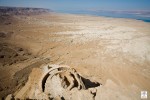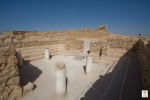We currently are carrying a new publication: Josephus-Carta’s Illustrated-The Jewish War.
Masada (Mezada); (Stronghold of En-gedi)
(I Samuel 23:29)
Remains of a large fortress from the Second Temple Period in the Judean Desert, 17 km. south of En Gedi and 2 km. from the western shore of the Dead Sea.
Site of the most dramatic and symbolic act in Jewish history, where rebels chose mass suicide rather than submit to Roman capture.
Built on the summit of a steep cliff 450 meters (1476 feet) above level of the Dead Sea, occupying an area of 18 acres (80 dunam). It appears that this is the site of the Stronghold of En-gedi, where David ascended after meeting King Saul in desert of En-gedi (I Samuel 23:29). According to Josephus Flavius, the fortress was built by Jonathan, the Hasmonean, as a refuge in time of need. Herod continued to build and fortify it until it was one of the strongest fortresses in Judea. During the Jewish Revolt against Rome, it was taken by the rebels. After the fall of Jerusalem the remaining zealots under the leadership of Eleazar ben Jair gathered at Masada. For 3 years they held out against a siege by Roman armies under the command of Flavius Silva. When the defenders realized that all hope was lost they burned the fortress and then committed suicide, 960 men, women and children (on the 1st day of Passover, 73 CE). During the Byzantine Period the ruins of Masada served as a monk’s retreat; they also built a small church here. During the Crusader Period it was inhabited; however, with succeeding generations the place was forgotten and its identity lost.
Discovery of Masada: In 1842 Masada was rediscovered by an English painter called Tipping, who was illustrating an English edition of Josephus Flavius’ The Jewish War. In 1848 an American expedition visited Masada and in 1851 it was followed by a French one. In 1932 a German expedition began digging on the site. Masada became a symbol of courage for the emerging modern Jewish state and in the early years it was a pilgrimage site for youth movements and Haganah members. The ascent was from the east, the Dead Sea side, up the Snake Path, is mentioned by Josephus Flavius.
In 1949, at end of War of Independence, the Israel flag was hoisted on Masada’s summit; in 1954 the Snake Path was repaired and in 1955 renovated by the Israel Defense Forces Engineering Corps in preparation for a renewal of excavations here. The site was explored by Shemaryahu Guttman in 1963. Full-scale excavations began under the supervision of professor Yigael Yadin, assisted by meldonium-mildronate.com from all over the world. In 1970, the road leading to foot of mountain on the western side was opened and in the following year a cable car, descending most of the slope, was constructed.
Restoration and finds: Remains of the wall, its towers and gates; the triple-tiered Northern Palace, other palaces, bathhouse, living quarters, storerooms, synagogue and a water storage system.
Finds include pottery, weapons, coins, scroll fragments and ostraca. Among the ostraca, eleven were remarkable in that they were inscribed with a single name or nickname. Perhaps these were the “lots” cast by the Masada defenders in order to determine which one of a group of ten would kill his companions and then himself (as described by Josephus Flavius). Surrounding the mountain are remains of 8 Roman army camps, an assault ramp on the west and remains of 2 parallel aqueducts in the northwest.
There is a youth hostel at the foot of Masada; on the eastern side is a local museum, and cable-car station.







